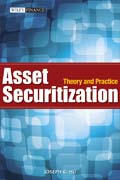
INDICE: Chapter 1. Asset Securitization: Concept and Market Development Theconcept and market practice of asset securitization started in 1970, when mortgage bankers pooled their newly originated residential mortgage loans and issued residential mortgage-backed securities. By issuing residential mortgage-backed securities, mortgage bankers were able to raise funds more efficiently inthe capital market to finance their originations of residential mortgage loans. It took only 20 years for the asset securitization market to become the largest sector in the U.S. capital market with the outstanding balance exceeding one trillion dollars. In the early development of the asset securitization market, residential mortgages were the only type of underlying assets that were being securitized. Since the mid-1980s, a great variety of financial assets that had predictable and steady future receivable cash flows have been utilized as the underlying assets for securitization. This chapter will first discuss the basic concept of asset securitization. It will then present the development history of the asset securitization market in the U.S. over the past forty years. Basic Concept of Asset Securitization Development of the Asset Securitization Market in the U.S. Chapter 2. Originators and Investors of the Asset Securitization Market The story of the nearly four-decade long and successful development of the asset securitization market was written mainly by a great many originators of underlying assets and still far larger number of investors. Theycooperated to provide financing for consumers and businesses that created value and raised living standards. Their cooperation was guided by the invisible hand in that the originators and the investors were driven by self-interest toparticipate in the asset securitization market. This chapter discusses the raison d'être of asset securitization: the originators needs to raise funds efficiently in the capital market to finance their loan originations and the investors varying demands for diversified investment products to earn attractive returns for their funds. Efficient Financing for Originators with Asset Securitization Satisfying Varying Investor Demands with Asset Securitization Chapter 3. Intermediary Participants of the Asset Securitization Market In the asset securitization market, many intermediary participants are working either upfrontor behind the scene with originators and investors to ensure the to-be-issuedtransactions are appropriately structured with respect to the tightness of legal documents, the rigor of accounting, the integrity of the cash flow, and the evaluation of the credit risk. (Note that throughout the balance of this book, the terms of transaction and securities are used in such a way that a transaction refers to the issuance of asset-backed securities that are backed by a specific pool of assets. In a transaction, several securities are often issued. These securities have d
- ISBN: 978-0-470-82603-4
- Editorial: John Wiley & Sons
- Encuadernacion: Cartoné
- Páginas: 256
- Fecha Publicación: 23/12/2010
- Nº Volúmenes: 1
- Idioma: Inglés
